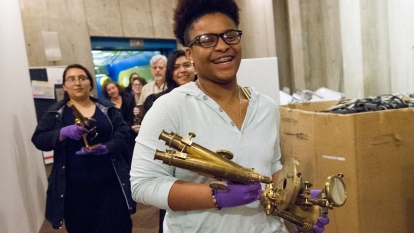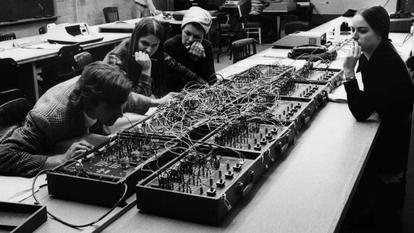
Wellesley Professors Find Cyanotypes Documenting Sarah Frances Whiting’s 1896 X-ray Experiments
In 1895, Wilhelm Röntgen discovered the X-ray, revolutionizing medicine and earning him a Nobel Prize in physics. Within weeks of his discovery, scientists across the world were trying to replicate his findings, including Sarah Frances Whiting, founder of the physics and astronomy departments at Wellesley. Her cyanotypes, cyan-blue photographic prints made using a mixture of iron compounds, showing her work were recently discovered at the College. In their article “Sarah Frances Whiting and the ‘photography of the invisible’” in the August 2020 issue of Physics Today, Wellesley professors John Cameron and Jacqueline Marie Musacchio describe Whiting’s work with X-rays and highlight the fact that she and her team were not only some of the first scientists in the country to replicate Röntgen’s new discovery, but also the first in an undergraduate college, and the first women, to do so.
Both professors have long been interested in the history of science and of science education for women, as well as the history of the College: Musacchio, professor of art history, co-curated a 2014 exhibit at The Davis of scientific artifacts found in Sage Hall, and Cameron, emeritus professor of biological sciences, recently shared with Wellesley magazine some of his favorite items from the College’s past.
“We want readers on and off campus to understand the early history of the College and the role of the amazing female faculty of that period."
—John Cameron and Jacqueline Marie Musacchio
In 2013, Cameron and Musacchio started preserving and cataloging artifacts found in Sage, such as scientific instruments, papier-mâché anatomical and botanical models, and wall charts—objects that were critical to the education of Wellesley science students in the earliest years of the College.
Their project took on urgency in 2018 when Sage was slated to be demolished to make room for the new Science Center. Everything needed to be cleared out of the building by May 2019. A team of students and a faculty/staff committee organized by then-Dean Ann Velenchik searched Sage and inventoried and stored more than 800 artifacts, including a nondescript box labeled “Diplomas” that contained several smaller 1970s-era Kodak boxes. One evening, Cameron took a closer look and discovered the Kodak boxes contained cyanotypes of Sarah Frances Whiting’s X-rays, with annotations on the reverse in her own hand. He contacted Musacchio, and they began to research Whiting’s career, using resources on campus and beyond, to put her experiments into context. Although a number of popular sources mentioned these experiments, they often did so in an exaggerated or inaccurate manner with no evidence, and the cyanotypes had never been published.
“We want readers on and off campus to understand the early history of the College and the role of the amazing female faculty of that period,” Cameron and Musacchio wrote in an email. “They overcame incredible odds and trained generations of students, but they have received relatively little credit for their efforts.”
Whiting’s 15 cyanotypes have been digitized and will eventually be included in Wellesley’s digital collections; in addition to the three reproduced in the Physics Today article, another six, with Whiting’s annotations, are available in a special feature on the journal’s website. Cameron and Musacchio want the actual cyanotypes to find a home in Special Collections, alongside other important related holdings documenting the history of science, where students can visit and learn more about Whiting and her work. They hope many of the other historic scientific objects will also be installed in a way that makes them visible to the College community in the future.
One hundred twenty-four years after Whiting’s experiments with X-rays, women are more underrepresented in physics than in most other STEM fields according to Yue Hu, chair of the physics department at Wellesley. “In recent years, the physics faculty and students at Wellesley College have worked together to revamp our academic program and to make our community more inclusive, so that students from all backgrounds and with a wide range of career interests can thrive,” she said. “Just before the COVID-19 pandemic hit last spring, we welcomed 28 new physics, astrophysics, and chemical physics majors—12 of them underrepresented minority and first-gen students. These numbers are significant, considering that fewer than 2,000 physics bachelor degrees are awarded to women among the 760 physics degree-granting departments in the entire country.”
“We are very proud of our long history of producing women physicists, and we will continue Professor Whiting’s legacy and work toward a brighter future,” said Hu.



